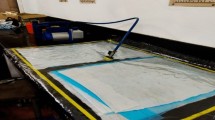Abstract
Aircraft manufacturers like Boeing and Airbus are currently designing new, high capacity aircraft, e.g., A3XX. To make this aircraft cost effective for the next 30 years, a strong impulse is given to the development of new technologies like the application of new aircraft materials. One of these studies investigates the feasibility of using the Fibre Metal Laminate Glare in the damage tolerance critical upper part region of the aircraft in order to reduce weight and increase safety. The present study investigates the crack resistance of Glare in case of foreign object damage as a function of the constituent's characteristics. An experimental program has been performed on Fibre Metal Laminates built up from several combinations of aluminium alloys and fibres. Especially the fracture mechanism was studied. It was found that a larger strain hardening region and a lower yield stress of the aluminium layers had a positive influence on the residual strength due to the capability of transferring high loads away from the cracked area. Increasing the stiffness and lowering the ultimate strain of the fibres reduces the residual strength, since stiffer fibres attract more load and because the final fracture is dominated by fibre failure.
Similar content being viewed by others
References
Vlot, A., Vogelesang, L. B., and de Vries, T. J., 'Towards Application of Fibre Metal Laminates in Large Aircraft', Aircraft Engineering and Aerospace Technology 71(6), 1999, 558-570.
Dilodovico, G. L., 'Influences of Metal Layer Properties on the Residual Strength of Glare', Master Thesis, Structures and Materials Laboratory, Delft University of Technology, The Netherlands, 1995.
Sihombing, K. M., 'The Application of Fx-fiber in Fiber Metal Laminate', Master Thesis, Structures and Materials Laboratory, Delft University of Technology, The Netherlands, 1999.
Apsoro, Y. A. R., 'Towards Fx FML', Master Thesis, Structures and Materials Laboratory, Delft University of Technology, The Netherlands, 1999.
ASTM Standard D3039-76, Standard TestMethod for Tensile Properties of Fiber-Resin Composites, Annual Book of ASTM Standards, Vol. 15.03, American Society for Testing and Materials, Philadelphia, USA, 1992.
Mattoush, A., 'Test Procedures for Fiber Metal Laminates', Report TD-R-93-003, SLI bv, Delft, The Netherlands.
ASTM Standard E561-86, Standard Practice for R-curve Determination, Annual Book of ASTM Standards, Metals Test Methods and Analytical Procedures, Vol. 03.01, 1988, pp. 570-581.
de Vries, T. J. and Pacchione, M., 'The Application of the R-curve Concept for the Prediction of the Residual Strength of Fiber Metal Laminates', Proceedings of the 1995 USAF Structural Integrity Program Conference, Vol. II, WL-TR-96-4094, San Antonio, 1996.
de Vries, T. J., Pacchione, M., and Galatolo, R., Applicability of Commonly used Fracture Mechanics Tools to the Prediction of the Residual Strength of Glare, ADIA 96-8, University of Pisa, Italy, 1996.
Author information
Authors and Affiliations
Rights and permissions
About this article
Cite this article
de Vries, T.J., Vlot, A. The Influence of the Constituent Properties on the Residual Strength of Glare. Applied Composite Materials 8, 263–277 (2001). https://doi.org/10.1023/A:1011256202539
Issue Date:
DOI: https://doi.org/10.1023/A:1011256202539




